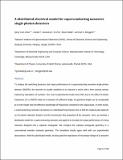A distributed electrical model for superconducting nanowire single photon detectors
Author(s)
Zhao, Qing-Yuan; Santavicca, Daniel F; Zhu, Di; Noble, Brian; Berggren, Karl K
DownloadSubmitted version (591.2Kb)
Terms of use
Metadata
Show full item recordAbstract
© 2018 Author(s). To analyze the switching dynamics and output performance of a superconducting nanowire single photon detector (SNSPD), the nanowire is usually modelled as an inductor in series with a time-varying resistor induced by the absorption of a photon. Our recent experimental results show that, due to the effect of kinetic inductance, for a SNSPD made of a nanowire of sufficient length, its geometrical length can be comparable to or even longer than the effective wavelength of frequencies contained in the output pulse. In other words, a superconducting nanowire can behave as a distributed transmission line so that the readout pulse depends on the photon detection location and the transmission line properties of the nanowire. Here, we develop a distributed model for a superconducting nanowire and apply it to simulate the output performance of a long nanowire designed into a coplanar waveguide. We compare this coplanar waveguide geometry to a conventional meander nanowire geometry. The simulation results agree well with our experimental observations. With this distributed model, we discuss the importance of microwave design of a nanowire and how impedance matching can affect the output pulse shape. We also discuss how the distributed model affects the growth and decay of the photon-triggered resistive hotspot.
Date issued
2018Department
Massachusetts Institute of Technology. Department of Electrical Engineering and Computer ScienceJournal
Applied Physics Letters
Publisher
AIP Publishing